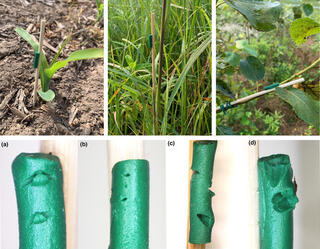Perennial crops promote natural pest control

Planting a variety of energy crops and maintaining landscape biodiversity reduces need for insecticides
The Science
Birds, rodents, and insects that prey on plant-eating bugs, like caterpillars, play a valuable role in farming by keeping pests in check. These natural exterminators are more active in diverse plant systems like prairies than in annual row crops like corn. For this study, researchers examined natural pest control in 10 different cropping systems that could be used to produce biofuels. They used fake caterpillars to reveal the frequency of attacks as well as what was preying on the pests. While attack rates varied, the study found insects were far more active throughout perennial systems, while most attacks in annual crops were done by mammals on the ground, often leaving the crop canopy unprotected.
The Impact
Research shows that natural predators provide at least $6.7 billion a year in value to farmers by increasing crop yields and reducing pesticide use. Because nearly all plans for slowing climate change require expanded use of bioenergy, it’s likely that farmers will plant more energy crops in the coming years. The type of plants and how they are placed on the landscape will affect natural pest control. Because row crops don’t provide enough food chain complexity to support these predators, expanding their footprint could erode ecosystem services and make farmers more reliant on insecticide. However, researchers believe large populations of natural predators in perennial crops could spill over into nearby annual crops.
Summary
To understand how different types of bioenergy cropping systems would affect this natural pest control system, scientists with the Great Lakes Bioenergy Research Center set up an experiment with 10 different cropping systems, including annual row crops like corn and sorghum as well as perennial prairie grasses, switchgrass, and poplar trees. They used fake caterpillars made from modeling clay, which records bite marks so that researchers can tell how often they were attacked and what was preying on them.
The results showed variations within and among the different systems, but in general predators were more likely to attack herbivores in perennial systems than in annual crops. In annual crop systems, birds and small mammals carried out nearly all the attacks, especially during the early growing season. By late summer, there were almost no attacks in the canopies of annual crops. In perennial systems, chewing arthropods – such as ants, beetles, spiders, and wasps – were responsible for most attacks, which increased over the course of the growing season. The results illustrate seasonal and spatial changes in predator activity and intensity and underscore the lack of food chain complexity in annual bioenergy cropping systems compared to perennials.
Contact
Nate Haan
University of Kentucky
nate.haan@uky.edu
Doug Landis
Michigan State University
landisd@msu.edu